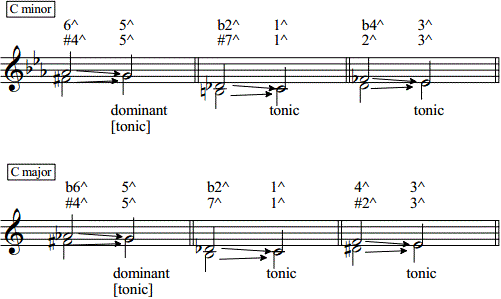|
||
| Section E. is not at all complete yet. In the moment only this is available: altered chords / sections 1-3, 5, and part of section 9 | SWITCH TO THE DUTCH VERSION |
1. general informationBefore going into the actual altered chords it is useful to think about the meaning of the terms alteration and altered tone. The term 'altered', when used in the context of altered chords, is used in a pretty specific way, which is not entirely consistent with its general meaning.An altered tone is a tone that is not diatonic in a specific key; the concept of alteration is therefore always linked with tonal or modal music: In the key of G major D# is an altered tone, as well as Ab. It should be noted that we can label some altered tones in major and minor keys in another way as well: we know the lowered sixth in a major key also asmolldur-sixth (or: b6^), and the raised sixth in a minor key as durmoll-sixth (or: #6^). These alterations are part of the so-called extended diatonicism, in which a major and parallel minor key arre 'mixed'.ann Logically, we can then speak of: mixture. For example: The tone Eb is b6 ^ in G major, and as if it were 'borrowed' from the parallel minor key; E natural in G minor is #6^, and as it were borrowed from the parallel major key. Even the use of the minor third in a major key, or the major third in a minor key sometimes can be seen as resulting from mixture, when these thirds can be seen as 'borrowed' from the parallel key.ann Sometimes even b2^ ann(in bII / Neapolitan) is seen as part of extended diatonicism. See example 1: |
| example 1 |
|
The
fact that a chord contains one or more altered tones does not automatically
mean that the chord itself is an altered chord. In most cases it is just
a 'normal' chord, because, even when it does not belong to the momentary
key, it can stand in one or several other keys. So, we can see it as 'borrowed'
from another key. When the chord can not be explained as part of extended
diatonicism, it is in miost cases a secondary dominant or secondary subdominant.
For example:
The altered chords form a separate group; this means that they share common characteristics that distinguish them from all other chords, and that we can precisely define them, as a group:
|
| example 3 |
 |
| example 4 |
 |
This means that only chords containing a diminished third are to be considered as altered chords. The diminished third then can be between root and third, between third and fifth, or (in seventh chords) between fifth and seventh of the chord. For example: |
| example 5 |
 |
|
In
practice, altered chords occur only at certain locations in the key. Put
differently: diminished thirds only can be used between specific tones
in a key: Only certain tones in major and minor keys can be raised
or lowered so that a diminished third arises. Diminished thirds should
shrink
when
resolving, and resolve to the prime (and the inversion of the diminished
third, the augmented sixth should spread when resolving, and resolve
to the octave). It turns out that there are only three possible 'resolution-points'
in the key:ann
|
| example 6 |
 |
|
When a diminished third
is used on #4^ a minor key is slightly more probable than a major key,
as we then have to alter only one tone (namely #4^), whereas we have to
alter two tones in major (namely #4^ and b6^ ) This does not mean though
that chords with this diminished third cannot occur in major. When we use
a diminished third on 7^ a minor key is slightly more probable than a major
key as well: the lowered 2^ is in minor keys a more 'normal' phenomenon
than in major keys (as lowering the 2^ in major causes an augmented second
between b2^ and 3^). Again, this not mean with this diminished third cannot
occur in major keys.
|
|
The diminished third
most often appears inverted in chords, as augmented sixth. And the
lower tone of the augmented sixth then furthermore normally is in the bass:
|
| example 7 | ||
|
||
 |
|
When
you know where in major and minor keys a diminished third can be placed,
you basically can find the corresponding chords yourself. Be aware of this:
In
the following sections I first go into the chords associated with the diminished
third between #4^ and (b)6^, because it is by far the most common. Later,
the other diminished thirds, with the corresponding chords, are also discussed.
In the moment, when writing chord labels or describing chords, I always
use the Dutch notation. Which means that you have to know
these abbrevations:
|
|